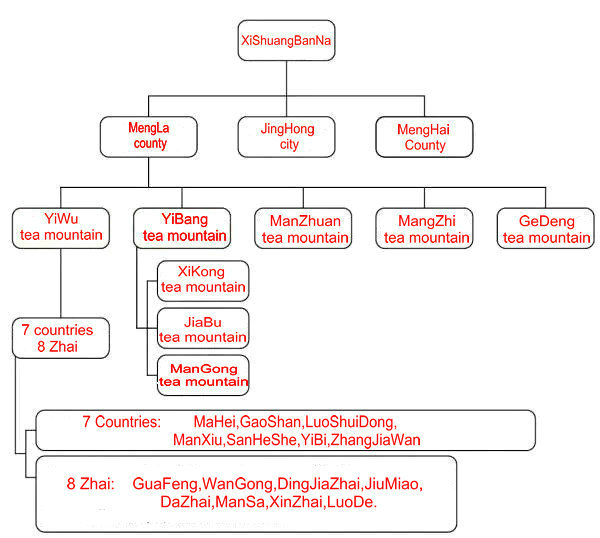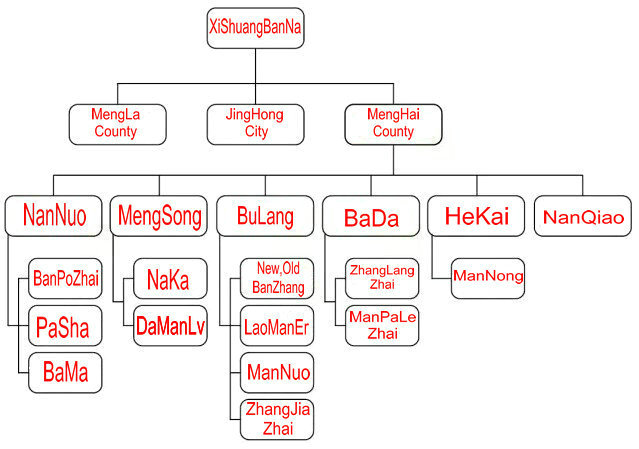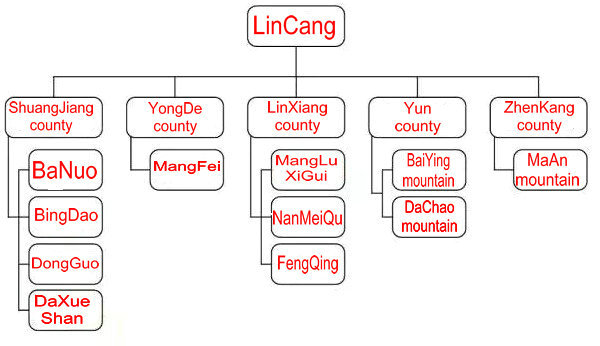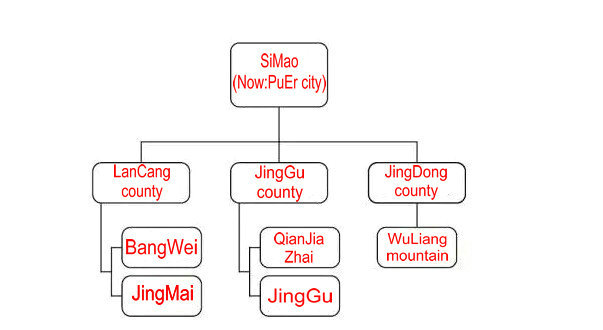The "Big 3" Puerh Tea Areas in YunNan province.
(If time permits, I will revise this blog written 4 years ago)
Maybe some people don't agree with me.
"Are there should be 5 tea areas instead of just 3? Such as YiWu, MengHai, SiMao,LinCang and BaoShan?"
"No,no, there should be 6 big tea areas. DaLi should be included"
Okay. Let me just talk about the big 3 tea areas along the LanCang river baisn. It is located in the south of North Tropic. This unique region belongs to tropical and subtropical climate. It is so special and very suitable for growth of tea trees. The tea quality is among the best in whole Yunnan province.
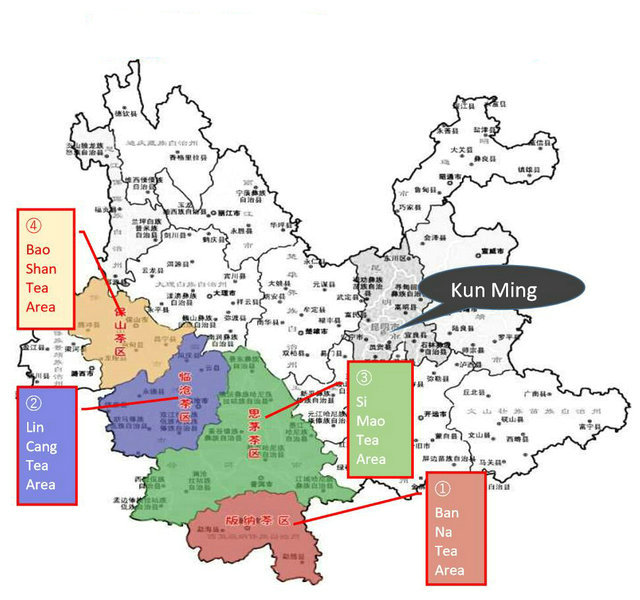 |
The big 3 tea areas. Source: 慢时光_Tina |
① BaNa tea area.
According to the recorded history, farmers started to plant tea trees from Eastern Han Dynasty (AD 25 year-220 year). Tea as a agricultural industry began to rise up from Tang and Song Dynasty(AD 618 year-907 year, 960-1279 year), and reached the peak during Ming and Qing Dynasty (AD 1368 year-1644 year-1912 year). Cha Ma Gu Dao which means tea and horse trading road starts from this region and crosses many mountains to outside China territory even to worldwide especially from the middle of 19th century. It used to be GongCha's chosen area in Qing Dynasty. GongCha means the tea just for royal family.
Thanks to it's unique geography, appropriate climatic conditions, fertile soil, adequate sunshine, suitable temperature, abundant rainfall, rich vegetation, this tea area has the most ecological environment during the big 4. There are tea plantation of 333 km². Among that, 86km² are well preserved old tree tea plantation.
It has 3 counties called JingHong, MengLa and MengHai. There are two very famous but little smaller tea areas of MengHai and YiWu. A proverb says "King BanZhang, Queen YiWu". BanZhang is in MengHai area and YiWu is not needed to say. The famous "Old six-famous-tea-mountain" except YouLe belongs to 3 villages of XiangMing,YiWu and ManLa, and all the 3 villages belong to MengLa county.
② LinCang tea area.
LinCang is located in the southwest of Yunnan. It has tea plantation of nearly 866.7km². Among that, wild ancient tree community shares 266.7km² and cultivated ancient tea plantation shares 433.3km² (hundreds years old tea plantation shares more than 60km²). The average temperature is of 17.5℃. Annual rainfall is near 1400mm. The north tropic crosses this area. Adequate sunshine, low latitude,high altitude, rich water resource and low PH all contribute to the suitable environment of tea trees. The oldest and largest tea tree till now was found in 2004 year at XiaoWan village of FengQing county. It has diameter of nearly 4m and age of around 3200 years.
The taste of tea in this area is different from BanNa. Both of them have their own characteristics. But the high-quality tea plantation and undeveloped tea area are larger than BanNa. It supplies the most tea materials for XiaGuan tea factory. And also to KunMing tea factory and MengHai tea factory, it is a very important base.
Because of the ecological environment, the tea is very rich in ingredients and has much variation of taste.
③ SiMao tea area.
SiMao was ever called in last 60 years and has been changed back to it's old name of PuEr which had lasted around 1700 years till the beginning of PRC. Puerh tea was not called puerh until emperor of QianLong(AD 1736-1796 year)gave this name to it (who knows what it was called before that? We only know there are many discussion of it during specialists and historians.)
It is located in southwest of Yunnan province. The almost completed well preserved ancient JingMai mountain and KunLu mountain and some other ancient tea areas belong to this region. It has tea plantation of nearly 678km². Arbor ancient tea plantation shares 233km² and modern cultivated tea planation shares 444.6km². The altitude is on average of 1200-1800m. The annual average temperature is around 17.8° C. Annual rainfall is between 1000-2000m. Monsoon comes with hot season. Sunshine is good. Red soil has PH of 4-6. Here, tea trees grow all year round.
It has the most harvest during the big 3 tea areas thanks to it's largest modern cultivated tea plantations. There are some very famous ancient tea plantation like JingMai mountain, ZhenYuan QianJiaZhai ancient tea plantation, YangGu DaBaiCha tea plantation.
One more thing. There is another tea area not included in big 3. But we can't ignore it especially when we think of the future of puerh tea industry.
④ BaoShan tea area.
It is located in west of Yunnan province and has the highest latitude and altitude but lowest annual average temperature and the least rainfall during all the major tea areas in Yunnan. Compares to other tea areas like Banna where many tea trees suffer over-picking, here many tea tree are in wild condition even need to be developed. In the future.
It has organic tea plantation of 100km² and ancient tea plantation of nearly 10km². Cultivated ancient tea plantations concentrate together. The representative one is TengChong Dam tea plantation, ShangYing WenJiaTang tea plantation and ChangNing MangShui village HuangJiaZhai tea plantation. Especially the GaoLi GongShan gushu has masculine and pure mountain rhyme of chaqi. This is very unique compared to big 3 tea areas. Also there is the most important base for harvest of DianHong black tea. From 1986 to 1987 year, ChangNing, TengChong and LongLing were firstly listed as base of export black tea.
<End>
Translator: John
Welcome to "https://www.kingteamall.com/354-2/" to find more interesting things.
* Reprinted from "http://blog.sina.com.cn/s/blog_6b64daa10102vsxc.html"
* The original author and translator have their own copyright.

